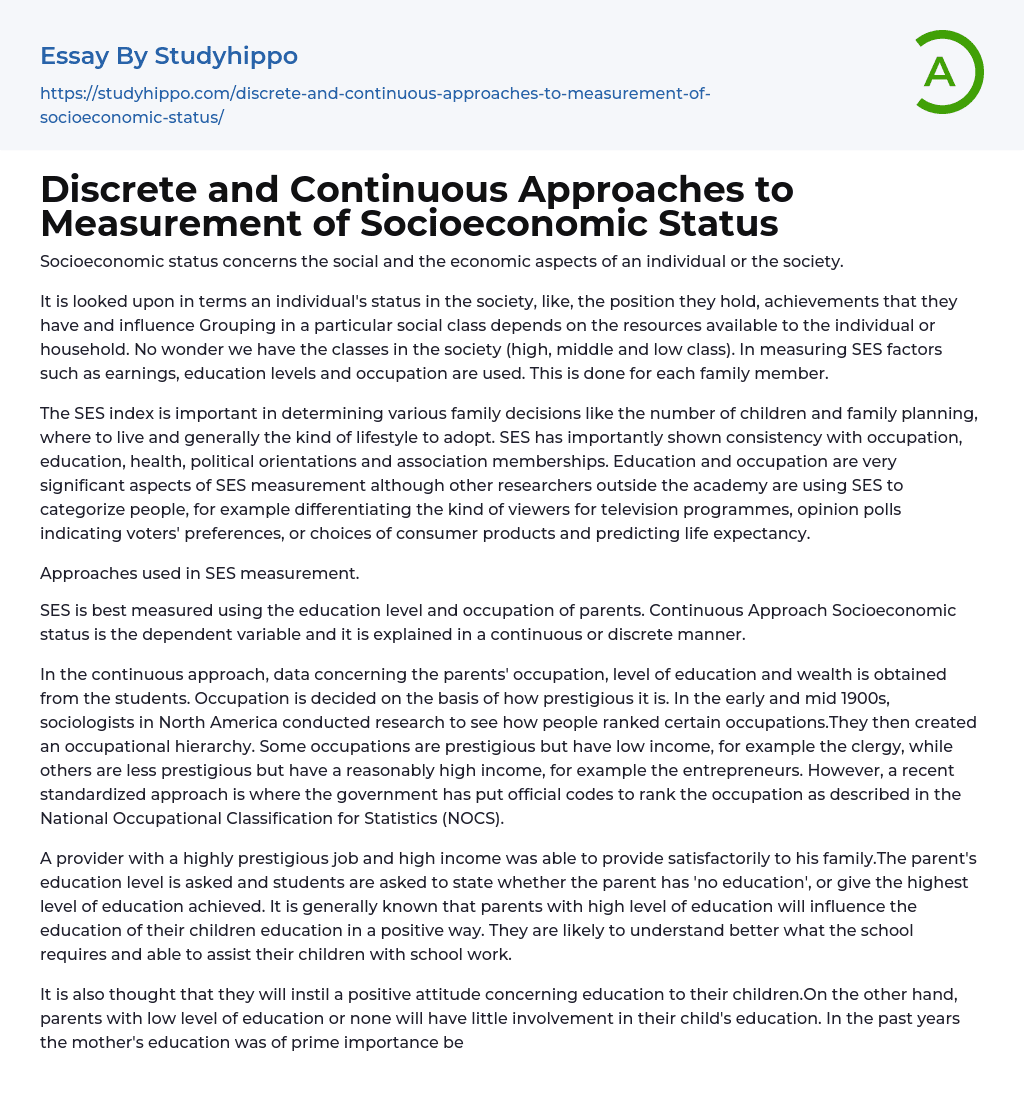

Discrete and Continuous Approaches to Measurement of Socioeconomic Status Essay Example
Socioeconomic status concerns the social and the economic aspects of an individual or the society.
It is looked upon in terms an individual's status in the society, like, the position they hold, achievements that they have and influence Grouping in a particular social class depends on the resources available to the individual or household. No wonder we have the classes in the society (high, middle and low class). In measuring SES factors such as earnings, education levels and occupation are used. This is done for each family member.
The SES index is important in determining various family decisions like the number of children and family planning, where to live and generally the kind of lifestyle to adopt. SES has importantly shown consistency with occupation, education, health, political orientations and association memberships. Education and occupation are very significant aspects of SES measurement although other resear
...chers outside the academy are using SES to categorize people, for example differentiating the kind of viewers for television programmes, opinion polls indicating voters' preferences, or choices of consumer products and predicting life expectancy.
Approaches used in SES measurement.
SES is best measured using the education level and occupation of parents. Continuous Approach Socioeconomic status is the dependent variable and it is explained in a continuous or discrete manner.
In the continuous approach, data concerning the parents' occupation, level of education and wealth is obtained from the students. Occupation is decided on the basis of how prestigious it is. In the early and mid 1900s, sociologists in North America conducted research to see how people ranked certain occupations.They then created an occupational hierarchy. Some occupations are prestigious but have low income, for example the clergy, while other
are less prestigious but have a reasonably high income, for example the entrepreneurs. However, a recent standardized approach is where the government has put official codes to rank the occupation as described in the National Occupational Classification for Statistics (NOCS).
A provider with a highly prestigious job and high income was able to provide satisfactorily to his family.The parent's education level is asked and students are asked to state whether the parent has 'no education', or give the highest level of education achieved. It is generally known that parents with high level of education will influence the education of their children education in a positive way. They are likely to understand better what the school requires and able to assist their children with school work.
It is also thought that they will instil a positive attitude concerning education to their children.On the other hand, parents with low level of education or none will have little involvement in their child's education. In the past years the mother's education was of prime importance because she contributes a lot in child education and socialization. Discrete Approach Discrete measure is also referred to as a categorical measurement.
This involves categorical groupings of the social classes. The social classes are not necessarily on a continuous or hierarchical manner but comparisons are made within a particular social class.
For example, concerning occupation, individuals are grouped according to the level of skill and skill specialisation so that we have people who are managers, administrators or clerks. while in education they are assessed on whether they attended any school, finished high school, have some college or university education.
Strengths and weaknesses of the continuous approach
The significance of the
continuous approach is that it is easy to show correlation with educational outcomes. Moreover, it is a simpler method to interpret in the regression type analysis.On the other hand, the continuous approach is not well understood by teachers and students on the education aspect but only with the researchers carrying out the study. Different contradicting methods have also been used in placement of social classes in accordance with education.
Strengths and weaknesses of the discrete approach
The good side of the discrete method is that it gives a straight forward understanding to the teachers and students. It also gives a clear distinction of important socioeconomic groups. On the other hand it does not provide a single common measure.Moreover, it can be cumbersome to interpret the regression type analysis.
Conclusion It is worth noting that both methods are important measures of reporting the social stratification.
Depending on the education levels, occupation, health the society is placed in various classes. Each class has its own style of interacting. Moreover, family decisions and values are passed on to the next generation depending on the social class set up. While the continuous approach measures SES over a period of time, the discrete method provides a comparison between the social classes at a particular period of time.
- Academia essays
- Higher Education essays
- Language Learning essays
- Studying Business essays
- Education System essays
- Study essays
- First Day of School essays
- Scholarship essays
- Pedagogy essays
- Curriculum essays
- Coursework essays
- Studying Abroad essays
- Philosophy of Education essays
- Purpose of Education essays
- Brainstorming essays
- Educational Goals essays
- Importance Of College Education essays
- Brown V Board of Education essays
- The Importance Of Higher Education essays
- Online Education Vs Traditional Education essays
- Academic And Career Goals essays
- Academic Integrity essays
- Brown Vs Board Of Education essays
- Distance learning essays
- Technology in Education essays
- Vocabulary essays
- Writing Experience essays
- Importance of Education essays
- Early Childhood Education essays
- Academic Degree essays
- Academic Dishonesty essays
- School Uniform essays
- Academic writing essays
- Cheating essays
- Bachelor's Degree essays
- MBA essays
- College Life essays
- Grade essays
- Diploma essays
- Phonology essays
- Sentence essays
- Filipino Language essays
- Pragmatics essays
- Millennium Development Goals essays
- History Of Education essays
- Graduate School essays
- Middle School essays
- School essays
- Special Education essays
- University essays



